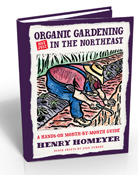Have Patience: Good Gardens Take Time
Posted on Monday, July 25, 2016 · Leave a Comment
One of the things I have learned over the years is that a garden needs time to develop and reach its full glory. The late children’s book author and illustrator – and gardener extraordinaire – Tasha Tudor once told me, “You need patience. It takes twelve years to make a garden. Everything that’s worthwhile takes time.” That seems a bit too long, but it does take time – years, in fact.
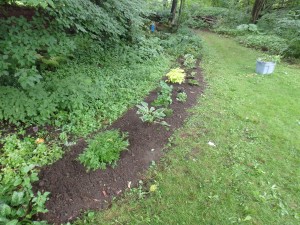
New shade bed
Recently I’ve been working on a shade garden that needed a pick-me-up. It has always been great in the spring with daffodils, snowdrops and scilla. There are lots of wild flowers and perennials, too, starting with hellebores that blossom beginning in late March and that have glossy dark green leaves all summer. Then come the primroses, anemones, Brunneras and finally hostas. All are green and pleasant now, but not dramatic. There wasn’t enough contrast for my taste. I have lots of groundcover – spotted dead nettle, or Lamium maculatum – that provided green and white foliage – but it’s somewhat boring right now.
So I created a new 3-foot wide curved bed about 30 feet long that replaces some of that ground cover and adds life to the wider garden area behind it.
I started by preparing the soil. It’s a shade garden, which means that there are a lot of tree roots in the space I wanted to plant. I defined the new bed by stretching out a garden hose defining a gentle curve. Using a pointed spade, I cut a sharp line into the soil 8 inches deep all along the hose, and then parallel to that 3 feet back from it.
Next I used a 4-tined weeding fork to pull the ground cover from the soil. This is a nice Italian tool made in a factory that has been making them the same way for generations. I got mine from Howland Tools in Shelburne Falls. MA (http://www.howlandtools.com). The curved12-inch long tines comb through the soil, finding and lifting roots. It’s like a 4-tined rake with extremely long tines. Some also call it a potato fork.
Tree roots were plentiful in my new bed so much of the soil’s fertility had been taken up long ago. The trees also suck water out of the soil, so removing roots helps in the short term (though I know they will return). I added organic slow-release fertilizer (one called Pro-Gro) and lots of compost – a couple of inches of it everywhere. I mixed it into the soil with that weeding fork, and then watered it repeatedly. Extra dry soil takes a long time to absorb water.
Since I like to plant according to the cycles of the moon, planets and stars, I consulted my Stella Natura calendar (www.stellanautra.com) and waited for a day auspicious for planting flowers. As it turned out, that was also a rainy day – the first in a long time here.
So what did I plant? In the middle I planted a perennial known as spikenard or Aralia cordata, one called ‘Sun King’. It gets to be a big plant, maybe 3 feet tall and wide, and has brilliant yellow-green leaves and does well in shade or part shade. Nearest the spikenard I wanted contrasting foliage, so I planted a black-leafed bugleweed (Ajuga reptens ‘Black Scallop’) and a glossy, dark green-leafed European wild ginger (Asarum europaeum).
Other plants I dug up and moved there were barrenwort (Epimedium spp.), two sizes of goatsbeard (Aruncus spp.) and a medium-sized green and white hosta. All were plants I had elsewhere. I matched the planting so that each side of the gardenwas a mirror image of the other – or as much as one can do with plants.
I spaced the plants based on how big they will be in 3 years. That means 2 or 3 feet apart for full-sized perennials. Of course that means the garden looked a little sparse when first planted, so I got a few annuals to fill in. I also planted some forget-me-not (Myosotis sylvatica) to transplant into empty spaces. That’s an annual or biennial with early spring blue flowers that grows everywhere in my gardens, hundreds of them. Thousands, perhaps. It’s a great filler.
The day after planting my flowers I went up to E.C. Brown Nursery in Thetford, Vermont to see about some shrubs to add to the mix. I got two pagoda dogwoods (Cornus alternifolia) to plant behind the newly planted border. Pagoda dogwood grows well for me –it’s a native shrub that often pops up in shady places.
Why did I need to buy two more? They had some with variegated-leafed specimens with green and white leaves. Leaves with some white look good in dark, shady places. These understory trees are small, and will take 4 or 5 years to get to a size where they’re dramatic. But that just goes back to what Tasha Tudor told me: Everything that’s worthwhile takes time. And maybe she’s right, maybe I’ll still be tweaking plantings in thisgarden for the next 12 years.
Henry is the author of 4 gardening books. Read his twice-weekly blog posts and see lots of photos by going to https://dailyuv.com/gardeningguy
How to Lead the Eye and the Visitor Through the Garden
Posted on Monday, July 18, 2016 · Leave a Comment
Garden clubs often enliven the summer by asking members to open their gardens to members and friends for an afternoon. For some, this is a terrifying day – they fear people will criticize their design, notice the weeds, make fun of the garden whimsy. For others, open gardens are fun. People walk through, talking plants and sharing ideas about how to create special garden spaces with plants that are right for the terrain. Clearly the second group of gardeners have more fun.
There is a group of gardeners in Lyme, NH that encourages garden visits: they call their events, “Pardon My Garden”. They acknowledge that few of us ever have a “perfect” garden, no matter how hard we work or how many weeders we employ. My garden isn’t perfect? So what. Gimme some ideas. I love the concept.
But let’s say you wish to open your garden to a group, or just to have a garden party for a dozen close friends. How do you get people to move around and find the special places and plants you have, especially if you have a large space? I think that hardscape is the answer: paths, archways, arbors, pottery, sculpture, stonework and water all will attract the eye and draw a visitor forward. Let’s look at these.
The most ambitious is to create paths. Public gardens use them to keep the foot traffic from killing the grass, and to direct people through the gardens. Often the walkways are covered with gravel and edged with steel or aluminum strips buried vertically in the soil. These pieces of edging often come in 20 foot sections and are serious work to install. I’ve done it, but it’s not easy.
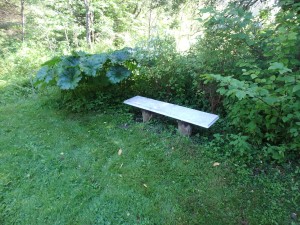
A marble bench and umbrella plant call out for visitors
In home gardens, paths between beds and from one part of the garden to another generally are grass. Sometimes people put down ground bark or wood chips to define paths, though I prefer grass. And flat stones work well, too, for short paths.
The only trouble with stone paths is that it’s tough to mow around stones if they are raised up at all. So if you install flat stones, be sure to dig out enough soil so that your stones will be even with the ground and you can mow the spaces between and around the stones. Sure, you can use a string trimmer to do the job, but that is slower – and hard work.
Wooden archways and arbors invite visitors to pass through them – to see what’s on the other side. I have made them out of bentwood and out of cedar posts. I have grown clematis, scarlet runner beans and wisteria on them. All are lovely. One word of advice if you are custom-making an arbor: design it so that your lawnmower goes through easily. Or make one that will allow an adult and a Labrador retriever to go through together – even if you don’t have a dog. Four to five feet is good.
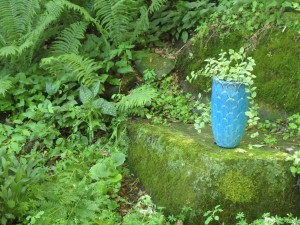
Pots of plants catch the eye
I recently weeded out a dry shady garden that has a nice piece of exposed ledge. I realized that I rarely noticed the ledge. I want visitors to pause and look at the unusual palette of plants I use in front of the ledge, too (now that the weeds are gone). What did I do? I moved a tall blue ceramic planter that I had on my shady deck down to the ledge. I have a vine with green and white leaves spilling out of the vase. It really brings the eye to that space.
If you have gardens on different levels, stone steps are great. Line them with plants that have interesting foliage that looks good all summer. People just want to walk up steps to see what is at the top (like the bear going over the mountain in that kids’ song). I put in steps a few years ago and they are a constant source of pleasure for me.
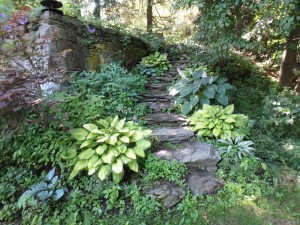
Stone steps draw visitors up to a new level
Fountains, pools, ponds, streams are good visual attractions, too. I am blessed with a natural stream, and find I am drawn to it daily. I keep the edges mowed so that weeds don’t obstruct the view.
Places to sit call out to visitors. I made a bench with a piece of white marble some years ago. Even though it is not a particularly comfortable place to sit (it’s hard, stone is cold, and it has no back) – it draws me across the lawn. It is enhanced by an umbrella plant (Darmera peltata) I planted in 2009 to honor my late sister. It is a dramatic plant: it has leaves 16 to 20 inches in diameter standing up nearly 4 feet tall.
My Adirondack chairs also beckon to me, and to visitors. I got wooden ones and painted them magenta. Even from a long distance, they stand out in contrast to the greens everywhere else. I gravitate towards them.
And ultimately, for gardeners, plants are the ultimate call. Have a magnolia in bloom? We all will walk to it. Roses? We want to sniff them – even if they are largely scentless, as most new roses are today. And even if your garden will never be on a gardentour, creating a draw will please you and your family.
Mid-summer Tasks in the Garden
Posted on Monday, July 11, 2016 · Leave a Comment
By now my gardens are well established and most plants are doing well. But there are tasks, both in the vegetable garden and in the flower beds, that need my attention.
Weeding is key in both areas, and recent rains make doing so easier as the soil has softened up. If you have very dry soil where you are, you might want to water well before weeding.

Mulched Onions
Why worry about weeds? I know gardeners who don’t do much weeding in their vegetable gardens. One even told me that if he weeded too much the deer would find his vegetables! But weeds anywhere in the garden are going to spread seeds soon – whether in the walkways or up close to your tomatoes. And seeds will come back to make more work now – and in the years to come. Many weed seeds act like time release capsules, some germinating now, some later, some 5 years down the road.
Weeds compete with your plants for moisture, soil nutrients – and even sunshine as they get bigger. I use a CobraHead hand weeder (www.CobraHead.com). It’s shaped a bit like a curved finger with a sharp pointy spade-shaped tip about an inch across. It easily gets under weeds so that I can pull from above (with one hand) and from below (with the CobraHead) at the same time, or tease long roots out of the soil without breaking them.
Thinning your carrots, beets and other root crops is an urgent job if you haven’t done so yet. Like weeds, vegetables growing too close to one another will compete for sun, water and nutrients. Carrots and beets should be at least an inch apart by now. And in a month, you need to thin them to 2 inches apart. Pulling the sharp tip of a CobraHead alongside a row of carrots will loosen the soil, sever a few side-growing roots, encouraging those that go deep. And scratch in some organic fertilizer now, too. It will help you get bigger carrots.
By the way, you can transplant carrots as you thin them out. Poke a hole deep enough so that the carrot will not bend, drop it in, press down the soil, water. It’s not a 100% reliable technique, but I hate to kill plants and have found it works most of the time. Do it in the evening, so they will have all night to recover before the hot sun hits them.
My onion patch was recently weeded, but I know that weeds will be along soon. So I mulched my onions with grass clippings. I find they work better than straw or hay in tight quarters like the onions. And green clippings may add a little nitrogen to the soil as they break down.

Leaves with early blight need to be removed
In many gardens the lower leaves of tomatoes are starting to yellow and develop dark blotches, sure signs of early blight. Although this blight is not immediately fatal, it reduces crop yield. By the end of August stems are often bare of leaves. You can minimize it by pruning off the affected leaves and all lower branches that touch the soil or are near it. Work on your plants when they are fully dry as the disease spreads more easily when leaves are wet.
I use scissors to remove the leaves, dipping them frequently in a glass of rubbing alcohol to sterilize them between plants. I wash my hands in a bucket of soapy water between plants. To see an in-depth article about this procedure along with many pictures, go to https://dailyuv.com/news/851634.
I always plant my potatoes in June, even though many gardeners start planting them in April. I do this as I ‘ve found that I have fewer potato beetles by planting late. Maybe they’re all at my neighbors’ gardens. But do take some time to check yours to see if any beetles are eating the leaves. Look for larvae, and for orange egg masses on the underside of leaves.
When you plant your potatoes the roots will grow down below the seed potatoes and the new potatoes will form above them. Now is a good time to add soil over the developing potatoes. This is known as hilling them. I plant mine using a post hole digger, so it’s easy to fill in above my seed potatoes, just pushing the soil from mounds next to each plant. You can also use a hoe and scrape soil from the walkways. Don’t worry if some leaves get buried. They won’t complain.
In my flower gardens I am mainly weeding and cutting back flowers stems that have already blossomed. Weeding gives me space to plant new flowers – even though I have an extensive palette of plants, I constantly go to garden centers to see new things, or plants I once had that have disappeared. (Yes, I kill a lot of plants, we all do).
Cutting off spent flowers is good. Important. It takes a lot of energy to produce seeds. By pruning back the spent flowers, your plants have more energy to develop good roots and strong stems.
So get outside and enjoy summer and pull some weeds. You garden will look better and you’ll feel better, too.
Henry is a UNH Master Gardener and the author of 4gardening books. His website is www.Gardening-Guy.com. Read his twice-weekly blog athttps://dailyuv.com/gardeningguy.
Freeing Up Prime Real Estate in the Garden
Posted on Monday, July 4, 2016 · Leave a Comment
As a gardener I find that inertia is my enemy. I plant things, and then just let them remain (whether I like them or not) – even if they take up a lot of space. I removed two such plants this summer. First, I cut down a pie cherry that produced blah-tasting fruit and not much of it. Next, I had a huge patch of lovage, a celery relative that over the past 20 years had spread to take up an 8-foot piece of prime real estate just outside my kitchen window.
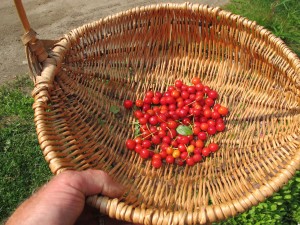
My Sour or Pie Cherry Harvest, 2015
I cut down the cherry, which was 15 feet tall and had a base diameter of about 3 inches, by lopping off the branches and cutting the trunk 2 feet above the ground. I knew that it would be easier to remove the stump if I left a section of trunk that would give me leverage as I rocked it back and forth, loosening the roots.
My young helper, Adam, did the digging and root removal – I’ve found that paying a helper for some of the heavy lifting makes sense at my age. I get to enjoy the garden more this year, now that tasks I don’t want to do still get done. I recommend it.
Removing the cherry tree means that an existing row of peonies will get full sun for much of the day – instead of filtered sun. That will give me more blossoms next year, and probably bigger ones. I’ve planted a new peony and two peach-leaved bellflowers flowers (Campanula persicifolia) where the tree was, and have room for more things. Most of my gardens have moist to soggy soil, but the tree was on a terrace with well-drained soil. So it’s a good place for the bellflowers, as they don’t like soggy soil.
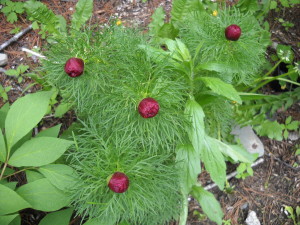
Fern-leafed peony in bud
The peony I planted is a relatively rare one, the fern-leafed peony (Paeonia tenuifolia). I got this from Cider Hill Gardens in Windsor, Vermont. It really does have fern-like leaves, which is rare in peonies. But the reason I love it is that it blooms in May, before most others, and it is bright red. A vivid red that will stop traffic – foot traffic, anyway, in my garden. It is a relatively delicate and I lost one after a hard winter. Maybe it’s best in Zone 5 or warmer. It is not a hybrid, and it has been crossed with other peonies to get early-blooming hybrids.
Outside the kitchen window, in prime viewing space, I have planted 3 delphiniums, another red peony (‘Nippon Beauty’) and an Angel’s Trumpet (Datura spp.). All three do best in full sun, though the Angel’s Trumpet can do fine in part sun.
Of the plants I installed outside the kitchen window, I‘ve had the worst luck with delphinium. I buy them, and they have not performed well for me – meaning that after the first year they haven’t come back. I’ve crowded them in the past, and they’ve gotten less than full sun.
But this time I will do it right: full sun, rich soil with added compost and plenty of slow-release organic fertilizer. These plants will bloom later this summer, and once they are finished blooming, I will cut them right to the ground and scratch in a cup of organic fertilizer around each plant. They may then bloom again in the fall, or maybe not. They should return and bloom next year. I’ll report back to you on that.
The peony will do fine, and will outlive me. I have a peony my grandmother grew, and she died in 1953. My mom dug it up, moved it to her house, and I got it from her in the 1980’s. Peonies move best, by the way, when they are starting to go dormant in the fall. The roots go deep, so be careful.
The trick for peonies is to plant them in rich soil and at just the right depth. If the “eyes” or buds are planted more than an inch below the soil surface, they will not bloom after the first year. So if yours aren’t blooming, clear away some soil until the eyes are at the right depth.
Angel’s trumpet, often referred to by its botanical name, Datura, is my replacement for the Oriental and Asiatic lilies. I can no longer grow the lilies because of that dastardly lily-leaf beetle. The red beetles cannot be controlled by hand-picking, and I refuse to use systemic poisons that kill the beetles. But Datura produces plenty of big white upward-looking blossoms. Once it starts to bloom, it continues blooming until frost, which is much longer than the true lilies bloom.
One word of warning: the seeds of Datura are poisonous – psychotropic, I have read. But they have spiny outer coverings, so I don’t worry about toddlers picking and eating them. And it the squirrels do? Darwin would approve.
So have a look around your property. Is there a tree that is producing shade that you don’t want? Get someone with a chain saw. It’s not a crime to kill a plant, especially if you are planting others to replace it.
Henry’s blog is at https://dailyuv.com/gardeningguy. His website is www.Gardening-Guy.com.
It’s Not Too Late to Start an Herb Garden
Posted on Monday, June 27, 2016 · Leave a Comment
Garden centers are mostly sold out of flowers and vegetables by now, but there seem to be plenty of herbs still for sale. Now that you have (hopefully) gotten your veggies and annual flowers planted, this is a good time to plant some herbs.
My vegetable garden –where I have always grown herbs – is somewhat remote from my house and down a set of stone steps. But this summer I have an herb garden between my car park and wood pile – just 10 steps or so from the house.
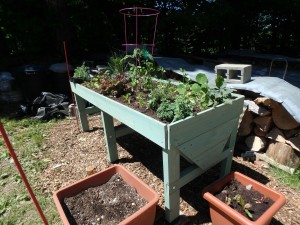
OLYMPUS DIGITAL CAMERA
So how do I grow parsley, sage, rosemary and thyme (and others not included in Simon and Garfunkel’s song) in a spot that sounds so inhospitable? I am growing them in a wooden container called a VegTrug that I got from Gardeners Supply (www.gardeners.com). It’s big and deep: six feet long, 2 feet wide and up to 18 inches deep in the middle of the V-shaped container. It is on legs and stands 30 inches high. Very nice, no bending over.
Filling up the VegTrug with appropriate planting mix is important: you can’t just dig garden dirt and shovel it in. The soil would compact and the plants wouldn’t thrive. But it takes over 400 quarts of soil mix to fill this behemoth. To buy that much potting mix would be pricey.
Getting the mix right is important: you want your mix to stay fluffy, hold water and offer nutrients. But if you just used a standard commercial potting mix, your growing medium would need weekly infusions of liquid chemical fertilizer. Adding compost introduces organic matter and beneficial microorganisms that work with the roots of your plants to share nutrients from the compost and organic potting soil.
I buy good quality compost each year that a local contractor makes from cow barn scrapings that he turns and aerates and makes into lovely light-weight compost that is relatively weed free. I mixed that compost with peat moss, “Moo-Grow” (an organic potting soil), organic fertilizer, limestone, perlite and vermiculite.
Vermiculite is a fluffy material made from heat-expanded mica that holds water. It is used in most potting mixes, though you might not notice it. I also added perlite, another heat-expanded mineral. It looks like Styrofoam, but is great for containers: it has a neutral pH, holds water and air, does not deteriorate or compress. I used a total of 6 quarts of each in my VegTrug. Perlite and vermiculite go a long way.
To make my soil mix I used a 5-gallon pail to measure, adding roughly 2 parts of compost and 2 parts of Moo-Gro potting mix to one part of peat moss. I stirred up that mix in a huge garden cart. I added half a cup of limestone per bucket of peat moss to counteract the acidity.
Once the ingredients were mixed, I add Pro-Gro, an organic bagged fertilizer. I used a total of 2 quart containers of Pro-Gro in the 100-plus gallons of soil mix I made. I added one quart of Azomite, a source of diverse mineral micronutrients, in the total mix. Azomite is optional. You could add rock dust instead, if you can get some very fine rock powder from a tombstone maker or a rock quarry. Or you can leave it out altogether.
It is important to get the ingredients well moistened before adding them to the VegTrug. I did this by adding water from my hose to the mix, and stirring with a shovel. Dry peat moss can be very hard to moisten; I wet it, stirred it, let it sit, and repeated until it seemed evenly moist.
So what am I growing? In the middle, where the soil is deepest, I have a tomato plant, one I started from seed called ‘Summer Sunrise’. The seeds came from the Hudson Valley Seed Library (www.seeedlibrary.org and is suited for container growing.
What else? I have about a dozen lettuce plants, 3 flat-leafed parsley plants, 2 kinds of sage, a rosemary and a thyme plant. I dug up a chunk of chives from my garden, cut it back and planted it in the VegTrug. Marjoram and a nasturtium are doing well – the latter has edible flowers, and will flow out and over from the VegTrug.
I planted dill and arugula by seed – both are up and doing fine, though I also bought a small pot of dill at my local Food Coop – another good source for pots of herbs. Lastly I planted a 4-pack of small basil plants. Everything is thriving!
Watering is important for containers. This VegTrug has shallow soil near the edges, deeper soil towards the middle, so the edges dry out quicker. I find I need to give it 4 to 6 gallons in hot, sunny weather. It only gets sunshine from 9am to 3pm, but that seems adequate.
So whether you invest in a VegTrug from Gardeners Supply or just grow some herbs in pots on the porch, go plant some. I am so delighted with my herb garden I know I will plant it again every year. And the collection of herbs in this nice cedar container is pleasing to the eye as well as the taste buds!
Read Henry’s blogs at https://dailyuv.com/gardeningguy. You can sign up for an alert every time he posts something, usually twice a week.
Dealing with Drought or Watering 101
Posted on Wednesday, June 22, 2016 · Leave a Comment
When it comes to watering, Mother Nature generally does it best. But as I write this, we haven’t had any rain in over a week and the soil is dry. Bone dry, and I am watering my vegetable garden most evenings.
In general, I don’t like overhead watering systems. Yes, they do mimic a rain storm, but they waste a lot of water, and water the walkways and weeds as well as the plants. So long as the soil is not parched, I like to water plants using a watering wand.
My watering wand is a 30-inch long aluminum tube with a watering rose on the end and a shut-off valve that allows me to increase or decrease the flow of water. I like those made by Dramm, a company that specializes in watering devices and has figured out how to deliver lots of water while not disturbing young plants.
In the vegetable garden, I walk up the rows directing the water around my tomatoes or irrigating the lettuce. The wand allows me to spray water close to the ground level – it’s not falling from waist high, the way a nozzle on the end of a hose would.
But in times like this, an extended period of hot and dry weather, I know I need to water each bed entirely, from side to side. Why is that? Imagine taking a sopping wet kitchen sponge and dropping it in a bucket of clean kitty litter. Then pour more litter over it. What happens? In five minutes the sponge would be dry. All the moisture would wick away. Your soil is a bit like that litter. It will absorb the moisture that you gave to the roots of your plants. So you need to soak the soil around your plants, not just at the rootball.
If you’re going to plant anything now, water the soil deeply several hours before doing so. It is easier to drench an empty bed than one with tiny seeds that might wash away, or little seedlings that can be harmed by a deluge.
Another effective way to keep plants moist in times of drought is to mulch. Mulch will keep the sun and breezes off the soil so that moisture does not evaporate so quickly. In the vegetable garden I cover most everything with newspaper – four to six sheets thick. I generally put the papers in a wheelbarrow and soak them first so they are less likely to blow away as I spread them out. Then I cover the papers with a thick layer of mulch hay or straw.
Straw is supposed to be seed-free, while hay is not. Straw is the by-product of threshing a grain – oats or barley, perhaps. But it comes from far away on a truck and costs about $10 a bale. Mulch hay, on the other hand, I can buy from a local farmer for $3 a bale. The hay is grown as feed for dairy cattle, but if it gets ruined by rain and the cows won’t eat it, it’s sold as mulch hay. Since I use 5 to 8 bales of mulch every year I rarely use straw.
One of the great things about the newspapers is that they keep most of the hay seeds out of the soil – or at least until late in the season when most plants are big and less threatened by weeds and grasses. I know that my earthworms love to eat the newspapers and maybe they eat the hay seeds, too.
I get e-mails from readers every time I suggest using newspapers in the garden. “What about the inks?” they write. In the old days inks were dangerous – they contained heavy metals. But now the inks are made from soy products. And yes, the paper making process might leave some stray chemicals in the paper itself, but I haven’t seen anything scary about it. I have read that one should avoid glossy colored inserts to the paper, or magazines. Cardboard is fine.
How do you know when you’ve watered enough? Dig down in the soil. It should be dark and moist for 6 inches after watering. In general, plants do fine with an inch of water a week, either from the sky or from your hose. But if you are using an overhead watering device, you probably will not get an even distribution of water. Put out cat food cans all over the garden to catch the water to see if areas got less water.
If you see your plants starting to droop, you know they’re thirsty. Today my bee balm, a perennial flower, is wilting. I didn’t rush to water it as soon as I saw this, as I know the plant is resilient and the roots are well established. Tonight, if I have time, I might give that bed some water. But if I saw my tomatoes wilting, I’d water right away. They’ve only been in the ground for about 3 weeks, so the roots are not extensive yet.
Always try to keep water off the leaves of plants. On a hot sunny day, drops of water can act like a magnifying glass, burning spots on leaves. And some fungal diseases require moisture in order to penetrate leaves and infect plants.
Watering is not rocket science. Keep the soil from drying out, particularly if you have seeds in the ground waiting to germinate. But don’t turn your soil into mud, either. Plants did fine before we invented hoses – but hoses sure are handy in times like this!
Read Henry’s twice-a-week blog at https://dailyuv.com/gardeningguy. He is the author of 4 gardening books and a children’s chapter book. His web site is www.Gardening-Guy.com.
How to Create a Secret Space for Children
Posted on Monday, June 13, 2016 · Leave a Comment
My sister Ruth Anne and I spent a lot of time on my grandfather’s farm in Spencer, Massachusetts when we were young. Grampy grew the most fabulous cukes, carrots and tomatoes – and flowers that would almost make the “faint of heart” swoon. I loved my time there.
One of the best features, on a hot afternoon, was a huge oval of forsythia bushes that enclosed a space where we could hide from adults and stay cool. I recently re-created such a space for my grandkids.
Kids like to have places that are secret and private. These days “helicopter parents” are said to be the norm. Even if you are not one, you might want to grow plants that will allow you to be nearby in case of emergency, but allow children the semblance of privacy.
So here is what I did: I planted 3 fast-growing willows about 10 feet apart. The one I planted is called ‘Hakuru-Nashiki’. At this time of year the leaves have pinkish tips, with white and green on them. Each of my shrubs had 3 stems when I bought it, and grew taller and wider each year. Now, 10 or more years later, they form a single mass of foliage about 15 feet tall. But the center of the planting is rather empty – a perfect place to make a “kid’s cave”.
To start, I entered the thicket, pruners and loppers in hand. I removed anything dead, or anything that was a potential “eye-gouger” – for me, or for a child. It didn’t take long to create a little cathedral with a domed ceiling full of brightly colored leaves.
Next I weeded out the floor of the space: there were ferns, brambles, some grasses and weeds. The soil was moist and most plants pulled easily. I didn’t bother pulling the grasses, but came in with my push mower and mowed them down.
I wanted to leave some vegetation around the edges of the space so that one could look out, but still feel secluded. There were some big iris plants growing along the stream edge that provided a screen. Years ago a friend offered to let me dig up some “nice yellow pond iris.” Little did I know, but that was an invasive iris, Iris pseudacorus. I tried digging it out, but like many invasives, that’s not possible. Even a scrap of root will grow back. It has spread, both by root and by seed. I have given up trying to get rid of it. It did make a nice screen for the edge of this new cave.
I like the willow as the structure for this hidey-hole. The branches arch up, touching at their apex. But other plants would work, too, but leave an open sky above. Lilacs, would work, for example, but take longer than the willows. And forsythia, I know works fine.
Common ninebark is a very fast growing shrub with a very dense habit that easily gets to be 8 to 10 feet tall. It blooms now, in June. I have a cultivar called ‘Diablo’ which has reddish foliage, but there are others including some with standard green leaves and a bright yellow-green leafed one called ‘Dart’s Gold’.
Ninebark will grow in sun or partial shade, wet or dry, good soil or bad. A cluster of these would create a nice enclosure. Each spreads 3 to 6 feet. My mature Diablo is only 18 inches wide at the base, but is over 6 feet wide at the top – which is 8 feet off the ground. I will prune it back, as I do each year, after it finishes blooming.
Don’t want to wait for shrubs to get big? Make a teepee of 8-foot poles tied at the top, and plant vines. Scarlet runner bean is a nice one and your kids can eat the beans! Morning glories are nice vines with colorful flowers. Purple hyacinth beans have lovely purplish leaves, and brilliant flowers, but take a long time to germinate. I would buy plants already started at my local garden center for those.
Many years ago my friend Emily Cromwell and her husband Mark Woodcock built a sunflower fort for her boys, Moe and Carlos when they were 4 and 6 years old (they’ve both graduated from college now, I believe). They marked out a rectangle in the lawn about 8 by 10 feet. Then they removed a 2-foot wide strip of sod all along the rectangle. They loosened the soil, and then planted 2 rows of sunflowers – with the help of the boys. They planted big sunflowers near the inside of the fort, shorter ones on the outside.
The nice thing about a sunflower fort is, for you helicopter parents, that you can see right in. But for young children, it will still seem like their own private space.
Kids spend too much time indoors. Create a special place to play, to read, to dream – and they will be outdoors of their own volition.
Read my blog posts at https://dailyuv.com/gardeningguy.
Tips for Planting, Weeding and Edging Your Gardens
Posted on Tuesday, June 7, 2016 · Leave a Comment
Are you still planting your vegetables? Here are a few tips. If your broccoli seedlings are a bit tall and floppy at planting time, you can bury part of the stem so they don’t flop over. I pinch of a lower leaf or two, and then plant the root ball 3 inches or so below the soil surface. Same for Brussels sprouts. Tall tomatoes I often plant sideways after I remove 2 or more of the lower branches. The buried portion will send out roots, which is helpful to the plant later on.
Most gardeners who start seedlings indoors plant 2 or more seeds in each cell, thinking that at least one will germinate. But what to do if they both did? I advise snipping off one of the two early on. But I had a six-pack of kale seedlings with 2 nice plants per cell that had somehow escaped my scissors. For some I snipped off one seedling at planting time, thus avoiding any disruption of the roots.
For others, particularly if the seedlings were growing in opposite corners of the growing cell, I separated them and planted both. To do this I hold the rootball in two hands, thumbs on the soil surface and nearly touching. Then I push my thumbs down, and gently pull them away from each other – and tearing the rootball in half. Sometimes the roots are so entwined that the break, other times they just pull away. Either is fine. Roots recover easily.
But what can you do if you have too many melons or an overabundance of okra? It’s very hard to throw them in the compost pile. Call your friends and neighbors, ask if they need some more plants. If you still have too many plants, deliver them to the community garden nearest you. Most have websites and contact info. I found one that will drive to my door to pick up vegetable and flower starts.
The bottom line is this: you don’t have to plant every seedling you grew or bought. You might have to buy a 6-pack of kale when you only want 2 or 3 plants. It’s okay to put the others in the compost pile if you can’t find a taker. That’s better than cramming them all into a small space.
After a recent day of heavy rain I spent much time weeding. Right after a rain when the soil is soaked is a good time to do so. Deep-rooted plants like thistles or dandelions are easier to pull when the soil is moist – or even soggy. If it’s soggy, of course, your feet can compact the soil, so stay on the lawn and work from the edges.
I have learned all the weeds that grow in my garden: some by Latin name, some by common name, a few I just call “Bob” or “Larry”. No matter. What is important is to know their roots. Annual weeds like jewel weed pull easily, all the roots coming with a scratch of my CobraHead weeder and a tug from above.
Other weeds, like perennial dandelions and burdocks, have tap roots that can go down 6 to 12 inches. For those I use a shovel to loosen the earth. I push it into the soil 4 inches from the weed, pull back on the handle, and the soil – along with the roots – loosen. Then with a tug the whole system comes out. If you break off a tap root, the weed will grow back, so it’s worthwhile taking the time to do it right.
Crabgrass, by the way, grows well in compacted soil – but lawn grass will not. That’s why it grows where you walk the most. Avoid it, if it bugs you, by putting down pavers to walk on. And if you set your mower at 3 or 4 inches the good grass may shade out the crab grass that is trying to establish itself now, in the early summer.
Ground ivy (Glechoma hederacea) – also known as Creeping Charlie or Jenny – is a pest to many of us because it grows in lawns and flower beds and will even grow in pure mulch! But it pulls easily and smells vaguely minty. Its leaves have scalloped edges and the flowers are generally a purplish blue. It sends down roots easily as it creeps into flower beds. I follow the roots with the tip of my CobraHead weeder, and they come out easily.
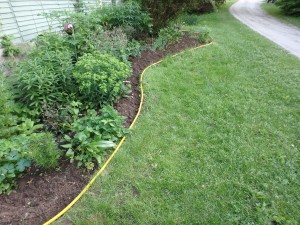
Formal garden edging
Edging the border of a flower bed makes it look tidy and professionally maintained. Basically edging means cutting a sharp edge to the bed with a shovel or an edging tool. By removing some soil after you have cut the edge, you create a little “moat”. Lawn grass sends roots exploring for new territory – but if it finds air, it stops growing. It can save a lot of time weeding out grasses later on.
If you have a straight flower bed, pull a string taught to establish the line you will edge. If you want to create curves, use your hose. Just lay it out in the lawn to establish the exact curves you want. I like to make flower beds bulge out into the lawn rather than follow straight lines. Just be sure that when you expand your beds and establish new boundaries, your lawnmower can follow the lines you establish
.
I try not to get too compulsive with my weeding. I get to the weeds when I feel like it. I try to pull them before they flower and set seed, but – obviously – that doesn’t always happen. That assures, however, there is always something to do in the garden.
Read Henry’s twice-a-week blog at https://dailyuv.com/henryhomeyer. You can sign up for an email alert every time he posts a new article.
Dealing with Pests and Diseases
Posted on Tuesday, May 31, 2016 · Leave a Comment
I understand why many gardeners shop on Death Row. That’s what I call the pesticide aisle at the garden center. Insecticides, fungicides, herbicides are sold in cheerful colorful bags, often with pictures of blooming flowers on the bag. I don’t shop there and try to avoid even walking down the aisle because the smell of death – poison – is often in the air.
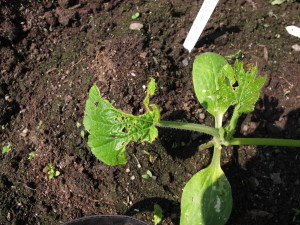
Leaves eaten by striped cucumber beetle
Gardeners shop on Death Row because something is threatening their roses or their broccoli. Flea beetles making holes in the cabbage? Nuke ‘em. Japanese beetles? Gotta kill ‘em. I get the urge, too. But there are alternatives.
Let’s start with something easy: I drape a light-weight gauzy film of agricultural fabric over plants to keep bugs from physically getting to my plants. This cloth allows sun and rain to pass through, but not bugs. It’s called row cover or by trade names like Reemay and Agribon. There are other brand names, too.
Row cover comes in different weights, and some heavier types can be used to keep in a little heat at night, holding off frost. But its best use is to keep plants bug-free. I use it over my vine crops like cucumbers and squash as they are very vulnerable to a pest called the striped cucumber beetle.

Row cover over young plant
Row cover is not perfect: striped cucumber beetles live in the soil, and sometimes will appear under the row cover, but mostly it prevents them from getting to the plants. To be on the safe side, I start cukes and squash inside the house 3 weeks or more before planting time (or buy a 6-pack of starts). That gives me good-sized plants that can survive some beetle attack.
Generally I just drape the row cover over the cucumber plants and pin down the edges with special staples sold for the purpose. It is light enough that it will just float on top. But since vine crops are insect pollinated, I need to take it off once the plants start to bloom.
Hoops are sold to support row cover, too. Five foot sections of #10 wire are sold for the purpose. Just poke one end into the soil, bend it, and poke in the other end. This is great for keeping flea beetles and cabbage moths of broccoli, cabbage and related plants.
Repellents can help to keep insects off plants. Liquid fish fertilizer has worked for me to reduce the number of Japanese beetles on roses and other decorative plants, though I wouldn’t use it on vegetables. Garlic Barrier is product made from garlic and citric acid that can be diluted and spread on plants to repel insects. It is rated for use on vegetables, and has no flavor once it has dried. In any case, you must get the repellents sprayed before the insects show up, and need to re-apply regularly. It is fine for use by organic gardeners.
Traps sound good, but generally are not. Japanese beetle traps use a sex hormone to attract the beetles, but unfortunately they attract many more beetles than they catch. And those pesky beetles like to have a snack before investigating the scent of sex. Give them to your neighbors, perhaps, but don’t use them!
Hand-picking bugs really does work, particularly if you are diligent when they first appear. Pick potato beetles every day as soon as you see them (or their larvae). Look under the leaves for orange egg masses, too. Don’t let a second generation get started! Get them early, and avoid trouble later on.
Keep these points in mind if you want have a good garden and healthy plants:
1) Healthy plants growing in favorable conditions (such as the right amount of sun, and moisture in the soil) are less susceptible to diseases.
2) Select disease-resistant cultivars when possible. Modern hybrids are often bred for disease resistance.
3) Don’t over-fertilize. Too much nitrogen gives fast green growth, but promotes weak tissue that is more susceptible to diseases.
4) Try to keep leaves dry when watering. Moisture on leaves, particularly at night, helps some fungal diseases to get established. A hand-held watering wand can direct water to the roots; overhead sprinklers get everything wet.
5) Prune off diseased leaves and dispose of them in the trash. Never let diseased plants over-winter in the garden. Keep your garden clean. Clean up in fall and spring to remove diseased plant matter.
6) Lastly, don’t overreact. Most fungal diseases won’t kill a healthy plant that is well planted in good soil. Don’t rush to spray chemicals. Once a leaf is infected, you can’t fix it, only live with it or cut it off.
As an organic gardener I accept that sometimes bugs or diseases win. I no longer grow Oriental or Asiatic lilies because of a beautiful red beetle that attacks them. I can’t control the pest by hand picking. That’s okay, I grow angel’s trumpet (Datura spp.), a lily-like flower that is even better – it blooms for many weeks with gorgeous big white flowers). And it doesn’t need chemical poisons to thrive.
Read my blog twice weekly at www.dailyUV.com. You can sign up to get the blog post sent to you be email.
Shrubs with Fragrant Flowers
Posted on Monday, May 23, 2016 · Leave a Comment
Some gardeners grow flowers for their beauty in the garden. Others for their magnificence in a vase. A few select species largely for their scent. My friend Nelia Sargent of Claremont is in this third category, largely because she is blind. I called her recently to see what flowering shrubs she likes best.
Nelia loves shrubs because they pack so many flowers in a small space. And, unlike most perennial flowers, have they their blossoms close to nose level. Who needs to bend over to sniff a peony if you have old fashioned shrub roses standing up 3 or 4 feet tall? Here are some of her favorites along with a few of mine –roughly in sequence of their blossoms.
First for her, in late March or early April, is a witchhazel hybrid (Hamamelis x intermedia) called ‘Arnold’s Promise’ This flowers heavily with yellow strap-like petals an inch long originating at a reddish calyx cup. Although this bush can get large – up to 20 feet tall and wide, I have never seen one half that size, here in the North Country. I have our native witchhazel which blooms in late fall, but this hybrid is a great plant and one I should get. It’s very fragrant.
At the same time (or soon thereafter) is February Daphne, a tidy pink shrub that is very highly fragrant. I love this one so much I named my corgi after it. I’ve had mine for a dozen years and never had to prune it, which is a plus. I’ve seen it growing wild by the side of the road, which makes me wonder if it will be invasive sometime in the next 50 years. But since I’ve not gotten one seedling and it grows slowly, I’m not too worried.
Nelia Sargent then listed a number of viburnums that are fragrant and lovely. Three that she mentioned are Viburnum juddii, V. carlessii, and V. burkwoodii. Don’t be put off by the Latin names. Just pronounce the species names like juddii with an E-I sound at the end. All three species were named after horticulturists.
Viburnum juddii gets to be 6 to 8 feet tall tall, with blossoms about 3 inches across. V. carlessii, also called Koreanspice viburnum, gets to be 4 to 5 feet tall and wide, with 2 to 3 inch semi-snowball flowers. The Burkwood viburnum can get 8 to 10 feet tall with spread about 2/3’s its height; like the others, its flowers are pink in bud, opening to white and highly fragrant.
In recent years there has been an invasive beetle that has terrorized many viburnum owners. Cornell University has listed viburnums according to their susceptibility. Burkwood viburnum was listed as moderately susceptible to defoliation, but V. carlessii and V. juddiiwere in the group least attractive to the beetle. You can see the entire list athttp://www.hort.cornell.edu/vlb/suscept.html. I have had a Judd viburnum 3 years and never seen one of the dreaded beetles.
After the viburnums bloom, and overlapping with them, are the lilacs. Nelia Sargent noted that there are early, mid-season and late lilacs, so one can have fragrant lilacs for at least 5 weeks. First for her comes one called Sister Justina, a white one that stays tidy and does not send up root suckers. ‘Gertrude Lesley’, a double white is also early and nicely fragrant. The common lilac, Syringa vulgaris, has 800 or 900 named varieties. Most are mid-season and nicely fragrant. These spread by root, sending up suckers that will create a hedge if you are not attentive.
Fragrant late season lilacs include Miss Kim (a cultivar of Syringa patula), a slow-growing variety that is (mistakenly) sometimes called a miniature. Mine is now over 8 feet tall, definitely not a dwarf! Another late beauty is ‘Donald Wyman’ (Syringa x prestoniae ‘Donald Wyman’) which is hardy to Zone 2 (minus 50 Fahrenheit) and will thrive despite pollution and compaction in wet or dry soils! One tough plant.
The final shrub on Nelia’s list is mockorange (Philadelphus coronarius). Not related to oranges, this 10 to 12 foot shrub has white blossoms that are sweetly fragrant. That said, be advised that not all cultivars are fragrant, so buy one in bloom. It is an old fashioned flower and not particular to soil type.
Roses can be lovely and fragrant, but many of the modern hybrids have little or no scent. The Knockout roses are fabulous disease-resistant roses that bloom most of the summer, but I’ve only encountered one that was fragrant. On the other hand, rugosa roses are highly fragrant, as are many of the old fashioned roses. I recommend buying them when in bloom if fragrance is important.
I agree with Nelia Sargent: shrubs with fragrant blossoms are a good addition to the landscape. And they are often great for our native pollinators, too.
Read Henry’s garden blog at https://dailyuv.com/henryhomeyer. You can sign up for an email link to the blog every time Henry posts something.

